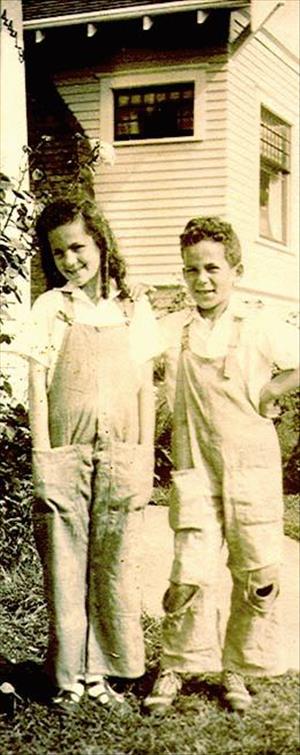Anne Gerber (1910-2005) enriched the spirit of Seattle through her lifelong support of local contemporary art, exposing the city to international cutting edge conceptual art through her biannual Anne Gerber Fund and the donation of a substantial collection Northwest Indian art to the Burke Museum. Her involvement and support of conceptual works like 557,087 led to the development of public art programs like In Public.
An A-Y-P Baby
Bert Convisar, Anne's father, was a printer by day and studied at the Chicago Art Institute at night. One night he saw a call for artists on the bulletin board, asking for sculptors to come to Seattle for the 1909 Alaska-Yukon-Pacific exposition. He came and helped to create temporary animal sculptures. He returned to Chicago for his girlfriend Bertha, married her, and brought her back to Seattle. Anne was born on July 23, 1910. She had a brother, Arthur, who died in 1924.
Anne studied art at the University of Washington. Her teachers were Ambrose Patterson, Raymond Hill, and Walter Isaacs. She thought Isaacs was a janitor until the beginning of her junior year, when she discovered he was the head of the department. Isaacs was a big influence. "He inspired me to love art ... and to see the environment around and to apply it to art. Art is all over," Anne recalls. "He used to nag us, saying, 'Remember, light on dark and dark on light,' and that's a marvelous thing."
Enter Sid Gerber
Anne was set up on a blind date with Sidney Gerber in 1931. Anne recalls how handsome he was and that he "was a liberal with a capital 'L.' " Sid was in the ski parts manufacturing business and they spent a lot of their leisure time at the sport. They had a long courtship before they married on May 6, 1935. Friends of the couple remember the great parties and picnics at their Medina home, filled with artists, politicians, and great food.
Anne remembers that by 1945, his business began to make a little money. Sid gave her an art budget. She would accompany him on his New York business trips and go to galleries she'd read about in ArtNews and in The New York Times. Among the twentieth century contemporary artists they collected were Max Beckman, William deKooning, Marc Chagall, and Paul Klee.
Collectors of Indian Art
Around 1950, they began collecting Northcoast Indian art after stumbling upon a sea of totems on an isolated island in Alert Bay near the Inside Passage. Anne recalls feeling unwelcome as no one came out to greet them, but Sid insisted that they stay until they made friends. They did so when they saved a fisherman and carver named Smith from ruin. It seems he had stayed home a whole fishing season to carve a totem ordered by a Seattle yachtsman who never picked it up, a dreadful thing. So Sid and Anne bought it.
Afterwards, Sid and Anne established a relationship with the carver and others from the tribe and began their extensive Northwest Indian art collection, much of which can now be seen at the Burke Museum. They also gave a lot of the pieces back to the tribe. The infamous totem can be seen at Daybreak Star Indian Center.
It was also in the early 1950s that they began collecting Northwest contemporary art. Their collection included Mark Tobey and Guy Andersen. They would go to art openings in private homes and attended dinner parties with the artists. It was vital to the local art scene that significant collectors of twentieth century contemporary art were supporting the local art community, giving them the recognition and clout they deserved. Anne would carry this tradition on.
Tragedy in the Cascades
On May 16, 1965, Sid was piloting a plane over the Stevens Pass area, carrying city councilman Wing Luke and secretary Kay LaDue when they encountered bad weather. The plane went down. An enormous search party was called out, but the plane was not found until October 5, 1968, more than three years after the accident.
After adjusting to her life with out Sid, whom she missed terribly, she began to bloom. He was a great persona and she always lived in his shadow. She thinks Sid is watching her and "is ok with it."
For Art That is Discovering Itself
Anne has spent much of her time since then continuing to collect and support contemporary, conceptual art. She has served on the Seattle Arts Commission several times. In 1987, two friends, Parks Andersen and Helen Gurvich, held a fundraiser to start an endowment in her name. The Anne Gerber Fund accepts donations and pays out interest biannually to bring a contemporary conceptual artist to the Seattle Art Museum. Specifically, the fund is used to support "risk taking art that would normally not get funded." Since its inception, recipients have included Joe Shapiro, Bill Woodrow, Alfredo Jaar, Fred Wilson, Lynn Hershman, Cindy Sherman. The next exhibit is scheduled for 2001.
Anne sat on the committee until recently. "It's important to me to go ahead in the mainstream of art, instead of emphasizing periods that are over. I like to watch for the art that's discovering itself."

